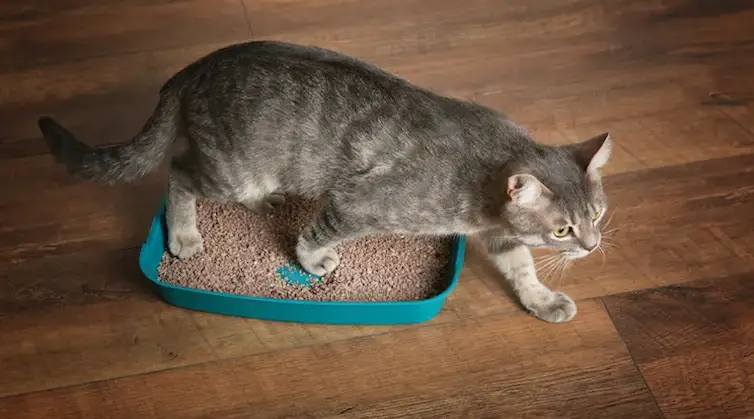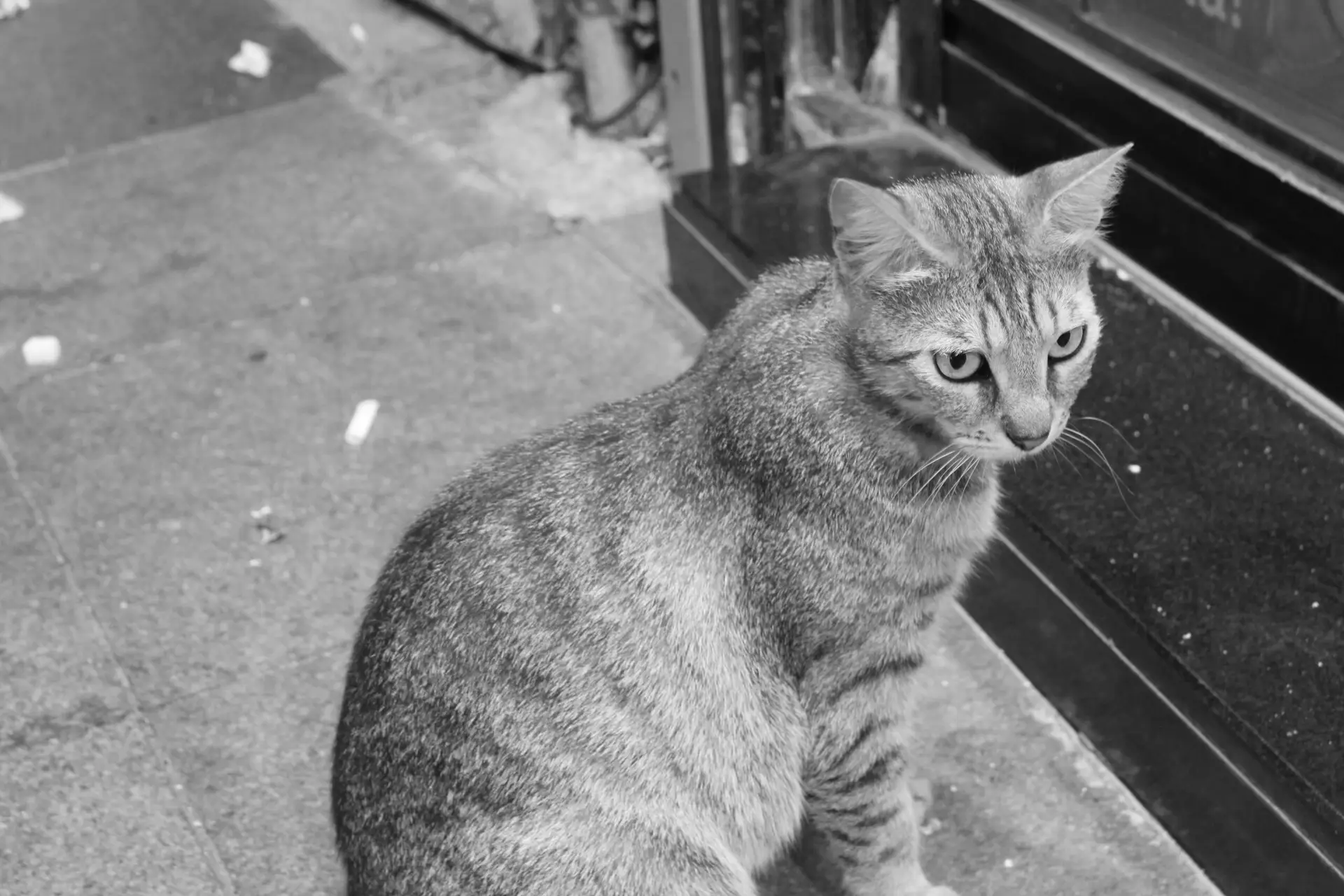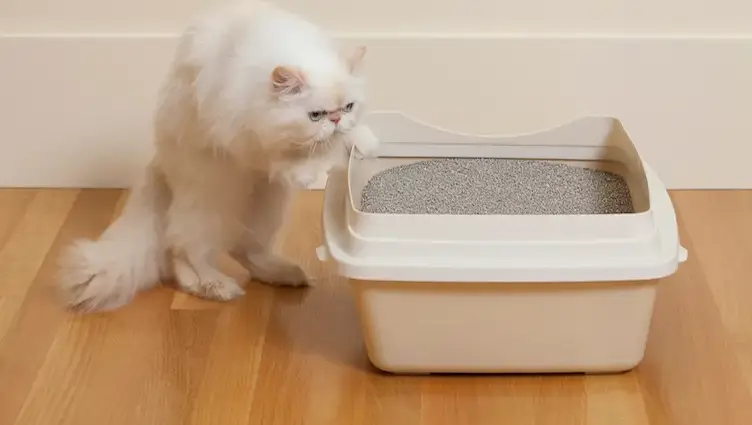Contents
- 1 Blood in Cat Urine: 7 Essential Causes and Solutions
- 1.1 Introduction
- 1.2 Understanding What’s Really Happening Inside Your Cat
- 1.3 Why is This Happening to My Cat?
- 1.4 How to Tell if Your Cat is Suffering
- 1.5 Who’s Most at Risk and How to Protect Your Beloved Pet
- 1.6 Getting to the Bottom of the Problem
- 1.7 Treatment Options That Bring Hope
- 1.8 Becoming Your Cat’s Home Health Advocate
- 1.9 What the Future Holds for Your Furry Friend
- 1.10 Your Most Pressing Questions Answered
- 1.10.0.1 Is this going to cost me a fortune?
- 1.10.0.2 Could I have prevented this somehow?
- 1.10.0.3 How quickly will my cat feel better?
- 1.10.0.4 Should I be worried about my other cats?
- 1.10.0.5 Will this keep happening over and over?
- 1.10.0.6 Can I do anything right now while waiting for the vet appointment?
- 1.11 A Message of Hope and Healing
- 2
Blood in Cat Urine: 7 Essential Causes and Solutions
Introduction
Suppose you’re cleaning your cat’s litter box, just like any other day, when suddenly you freeze. That’s not the usual yellow you’re used to seeing – there’s a pink tinge, maybe even bright red streaks in your furry friend’s urine. Your heart skips a beat, and a thousand worrying thoughts race through your mind. If you’re reading this article, chances are you’ve just experienced this exact moment of panic that every cat parent dreads when discovering blood in cat urine. Blood in cat urine is genuinely scary to witness, but take a deep breath – you’re not alone in this journey. While blood in cat urine should always be taken seriously and examined by a veterinarian, many underlying causes are treatable. The good news is that most cases of blood in cat urine respond well to proper treatment, and your beloved feline companion can return to their normal, healthy self with proper care and attention.
 Understanding What’s Really Happening Inside Your Cat
Understanding What’s Really Happening Inside Your Cat
What Exactly is Hematuria?
When veterinarians talk about “hematuria,” they’re simply referring to blood in your cat’s urine. But here’s what’s really going on: imagine your cat’s urinary system as a series of pipes and filters. Just like in your home’s plumbing, when something goes wrong anywhere along the line – whether it’s the kidneys (the filters), the tubes connecting everything (ureters), the storage tank (bladder), or the exit pipe (urethra) – problems can arise.
Sometimes you’ll see the blood clearly – your cat’s urine might look like pink lemonade, or even dark red like cranberry juice. Other times, the blood is microscopic, invisible to your naked eye but detectable when your vet runs tests. Think of it like having a tiny leak in your plumbing that you can’t see but shows up when a professional inspects it.
The Two Types You Might Encounter
The “Oh No, I Can See It” Type (Gross Hematuria): This is when you immediately know something’s wrong. The urine ranges from light pink (like your cat just had a sip of strawberry milk) to deep red or even brown. It’s the type that makes your stomach drop and sends you straight to Google at 2 AM.
The “Sneaky Hidden” Type (Microscopic Hematuria): Your cat’s urine looks completely normal, but during a routine vet visit, microscopic analysis reveals tiny amounts of blood. It’s like your cat’s body is whispering that something’s not quite right, even though everything looks fine on the surface.
Why is This Happening to My Cat?
Urinary Tract Infections – The Common Culprit
Just like humans can get UTIs, so can our feline friends. Think of Sarah, a cat owner from Portland, whose 8-year-old tabby Whiskers suddenly started leaving pink puddles outside the litter box. It turned out to be a simple bacterial infection – scary to see, but easily treatable with antibiotics. Female cats are slightly more prone to UTIs because of their anatomy, but any cat can develop one.
Feline Lower Urinary Tract Disease (FLUTD) – The Mystery Condition
FLUTD is like the “catch-all” diagnosis that makes many cat parents feel frustrated. Imagine your cat’s bladder becoming as sensitive as an inflamed wound – everything irritates it. Your normally calm kitty might suddenly act like using the litter box is torture. This condition often strikes younger to middle-aged cats and can be triggered by stress (yes, cats get stressed too!), diet changes, or sometimes seemingly nothing at all.
Stones and Crystals – The Sharp Troublemakers
Picture tiny, sharp rocks forming in your cat’s bladder – that’s essentially what urinary stones are. These mineral deposits scrape against the bladder walls like sandpaper, causing bleeding and intense discomfort. It’s like having pebbles in your shoes, but infinitely worse because it’s happening inside your cat’s most sensitive areas.
Cancer – The Word No One Wants to Hear
While less common, bladder tumors can occur, especially in senior cats. It’s the diagnosis every pet parent fears, but remember that early detection and treatment can make a significant difference. Don’t let this possibility paralyze you with fear – focus on getting your cat the help they need.
Accidents and Trauma – When Life Happens
Sometimes our adventurous felines get into situations that result in internal injuries. Maybe your indoor cat finally escaped and got into a fight, or perhaps they took a tumble from their favorite high perch. Physical trauma can damage the delicate urinary system, leading to bleeding.
How to Tell if Your Cat is Suffering
The Obvious Signs That Break Your Heart
Watching your cat struggle with urinary issues is emotionally devastating. You might notice them making frequent trips to the litter box, squatting for what feels like forever, producing only tiny drops of bloody urine. The worst part? They might cry out in pain, and those little meows will pierce your soul. Some cats start avoiding their litter box altogether – not out of spite, but because they associate it with pain.
When to Drop Everything and Rush to the Emergency Vet
If your cat (especially male cats) cannot urinate at all, this is a life-threatening emergency. Imagine trying to breathe through a straw – that’s how blocked cats feel, except it’s their ability to eliminate toxins that’s compromised. Other red flags include complete loss of appetite, hiding, extreme lethargy, or vomiting. Trust your instincts – you know your cat better than anyone.
Who’s Most at Risk and How to Protect Your Beloved Pet
| Risk Factor | What This Means for Your Cat | How You Can Help |
| Age | Senior cats face higher cancer risks, like elderly humans | Schedule more frequent check-ups after age 10 |
| Being Male | Boys are more prone to dangerous blockages | Watch their litter box habits like a hawk |
| Poor Diet | Cheap food with high ash content creates crystals | Invest in quality food – your cat’s health is worth it |
| Stress | Major life changes can trigger urinary problems | Keep routines consistent, provide safe spaces |
| Carrying Extra Weight | Overweight cats struggle with urinary health | Help your chunky kitty slim down gradually |
| Not Drinking Enough | Concentrated urine breeds problems | Make water irresistible with fountains and multiple bowls |
| Dirty Litter Boxes | Would you use a filthy bathroom? Neither will they | Scoop daily, wash weekly, provide multiple options |
The Food Connection That Could Save Your Cat’s Life
Here’s something many cat parents don’t realize: that bargain cat food might be setting your feline up for urinary problems. High-quality food with balanced minerals acts like insurance for your cat’s urinary health. Wet food is particularly beneficial because it naturally increases water intake – think of it as sneaking extra hydration into every meal.
Creating a Cat Paradise That Prevents Problems
Cats are creatures of habit who thrive on predictability. That new roommate, the recent move, or even rearranging furniture can stress your cat enough to trigger urinary issues. Create multiple “safe zones” throughout your home where your cat can retreat when feeling overwhelmed.
Getting to the Bottom of the Problem
What to Expect at the Vet Visit
Walking into the veterinary clinic with your sick cat is nerve-wracking. Your vet will gently examine your cat’s belly, feeling for a distended bladder, pain, or unusual masses. Don’t be surprised if they ask detailed questions about your cat’s behavior, diet, and home environment – they’re detective work helps pinpoint the cause.
The Tests That Reveal the Truth
The All-Important Urine Test: This simple test is like a window into your cat’s urinary system. It reveals bacteria, crystals, blood cells, and other clues about what’s going wrong inside.
Blood Work: These tests check if your cat’s kidneys are functioning properly and rule out other health issues that might be contributing to the problem.
The Photo Shoot (X-rays and Ultrasounds): Modern imaging lets vets see inside your cat without surgery. Stones show up clearly on X-rays, while ultrasounds provide detailed pictures of soft tissues and can spot tumors or inflammation.
Treatment Options That Bring Hope
Medications That Work Miracles
Antibiotics for Infections: When bacteria are the culprit, antibiotics work like tiny soldiers fighting the infection. Most cats start feeling better within 24-48 hours of starting treatment.
Pain Relief: Nobody wants their cat to suffer. Anti-inflammatory medications and pain relievers help your feline feel comfortable while healing.
Muscle Relaxers: These medications help stop painful bladder spasms, allowing your cat to urinate more comfortably.
When Surgery Becomes Necessary
Sometimes surgical intervention is the only way to help your cat. Stone removal, tumor extraction, or emergency procedures to clear blockages can be life-saving. While surgery sounds scary, veterinary surgical techniques have advanced tremendously, and most cats recover beautifully with proper care.
Supporting Your Cat Through Recovery
IV Fluids: Think of this as giving your cat’s urinary system a thorough rinse. Increased fluid intake helps flush out bacteria, crystals, and debris.
Special Diets: Prescription foods are formulated to dissolve certain types of stones and prevent future formation. Yes, they’re more expensive than regular cat food, but they’re often worth every penny.
Stress Management: Sometimes the best medicine is simply reducing your cat’s anxiety through environmental changes and consistent routines.
Becoming Your Cat’s Home Health Advocate
Mastering Litter Box Detective Work
Your cat’s litter box becomes a health monitoring station. Choose unscented, clumping litter that makes it easy to spot changes in urine color or volume. The “one box per cat plus one extra” rule isn’t just a suggestion – it’s crucial for monitoring individual cats’ health in multi-cat households.
Turning Your Cat into a Water-Drinking Champion
Some cats are naturally reluctant drinkers, which concentrates their urine and increases problem risks. Try water fountains (many cats prefer moving water), multiple water stations throughout your home, and wet food to boost hydration. Some cats even prefer drinking from faucets or large, shallow bowls.
Medication Time Without the Drama
Giving medication to cats can feel like an Olympic sport. Pill pockets, liquid medications mixed with food, or crushing pills into treats (when approved by your vet) can make the process less stressful for everyone involved.
What the Future Holds for Your Furry Friend
The Light at the End of the Tunnel
Here’s the good news that every worried cat parent needs to hear: most urinary problems are highly treatable. Simple UTIs usually clear up completely with antibiotics. Even chronic conditions like FLUTD can be managed successfully, allowing cats to live comfortable, happy lives. The key is working closely with your veterinarian and being vigilant about prevention.
Keeping Problems at Bay
Once your cat recovers, you’ll become an expert at prevention. Regular vet checkups, maintaining ideal body weight, providing stress-free environments, and feeding appropriate diets dramatically reduce recurrence risks. Many cat parents find that going through a urinary health scare makes them better, more attentive pet owners.
Your Most Pressing Questions Answered
Is this going to cost me a fortune?
While veterinary care involves costs, early treatment is almost always less expensive than dealing with advanced conditions. Many animal hospitals offer payment plans, and pet insurance can help offset major expenses. Consider the cost of treatment as an investment in years of continued companionship with your beloved cat.
Could I have prevented this somehow?
Please don’t blame yourself. Many urinary conditions develop despite excellent care. Focus your energy on helping your cat recover and preventing future problems rather than dwelling on guilt.
How quickly will my cat feel better?
Most cats show improvement within 24-48 hours of starting appropriate treatment. However, complete healing may take days to weeks depending on the underlying cause. Your patience and consistency with treatment are crucial for full recovery.
Should I be worried about my other cats?
UTIs aren’t contagious between cats, but environmental factors that trigger FLUTD (like stress or poor water quality) can affect multiple cats in the same household. Monitor all your cats closely and consider preventive measures for the entire family.
Will this keep happening over and over?
With proper management, many cats never experience urinary problems again. Others may need ongoing monitoring and prevention strategies. Your veterinarian will help you develop a long-term plan tailored to your cat’s specific needs.
Can I do anything right now while waiting for the vet appointment?
Ensure your cat has access to fresh water and monitor their litter box usage closely. Document any changes in behavior, appetite, or urination patterns to share with your veterinarian. However, avoid giving human medications or attempting home remedies, as these can be dangerous for cats.
A Message of Hope and Healing
Discovering blood in your cat’s urine feels like your world is crashing down, and those feelings are completely valid. The good news is that you’ve taken the most important step by recognizing the problem and seeking information. Your quick action and dedication to your cat’s health make all the difference in their recovery journey.
Remember that you and your cat are not facing this alone. Veterinarians understand the deep bond between pets and their families, and they’re committed to helping both of you through this challenging time. With proper diagnosis, appropriate treatment, and your loving care, most cats with urinary problems return to their normal, mischievous selves.
Your cat depends on you to be their health advocate, and by reading this article, you’ve shown that you’re exactly the kind of caring, responsible pet parent they need. Trust in the treatment process, follow your veterinarian’s guidance, and know that brighter, healthier days are ahead for both you and your feline companion. The journey might feel overwhelming right now, but with patience, persistence, and lots of love, you’ll get through this together.
Helpful Resources for Cat Parents:
- American Association of Feline Practitioners (AAFP) – Feline Lower Urinary Tract Disease Guidelines: https://catvets.com/guidelines/practice-guidelines/flutd-guidelines
- Cornell Feline Health Center – Comprehensive Feline Health Information: https://www.vet.cornell.edu/departments-centers-and-institutes/cornell-feline-health-center
- American Veterinary Medical Association (AVMA) – Pet Health Resources: https://www.avma.org
- International Cat Care – Evidence-Based Feline Health Information: https://icatcare.org
- Pet Poison Helpline – 24/7 Emergency Support: https://www.petpoisonhelpline.com



